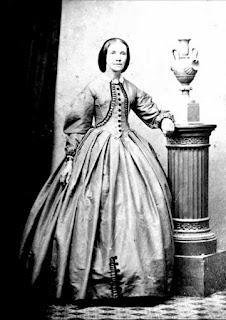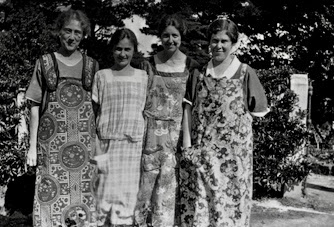12/52 Joined together: Charlotte Louisa Hobbs 1863 - 1928
12/52 Joined together : Charlotte Louisa Hobbs
Charlotte Hobbs is my favourite ancestor, if favourites are allowed. Her daughter Margery, my grandmother, saved her mother’s letters and I have transcribed them. It took me years, during which time I completely immersed myself in her life. I grew to love her. She became a real person to me and I looked to her for strength and support. Her love for me flowed down the generations although she died in 1928 long before I was born. When facing a decision I have asked myself : What would Charlotte do?’
Charlotte had cousins living in Tungkillo, a mining and farming village in the hills behind Adelaide. Her grandfather had a relation who had migrated to South Australia in 1847, two years before grandfather. He settled in Tungkillo. This Job Hobbs had a large family providing generations of Hobbs cousins. Charlotte enjoyed holidays with them in the country. At the Tungkillo Hotel lived the Godlees. The youngest child, Theodore and Charlotte were to marry, although that was in the future. I imagine it was here in Tungkillo that their eyes first met across the pews in Church or they chased each other across the paddocks. Or at least the two families, the Godlees and the Hobbs, became acquainted.
Charlotte Louisa Hobbs was born in Marden by the river Torrens. Her mother was Rebekah Harris and her father was Jonah Hobbs, 14 when he arrived in Adelaide with his parents and sisters from Wiltshire. He had made good. He had built a house of river stone and established a market garden, married Rebekah, his neighbour. Charlotte was their third child, born in 1863. She was a survivor. Between 1864 and 1872 Jonah and Rebekah lost five infant children. There was an epidemic of Scarlet Fever so that is a likely cause of these terrible deaths. The last infant death in 1872, left Charlotte aged 10 and her brother Harris, aged 3. Rebekah then had three more children who grew to adulthood, Lillian Ethel 1874, Frank 1876 and Mabel 1878.
Charlotte went to school at Mrs Shuttleworth’s Hardwick House, Young Ladies College in Kent Town. It was possible to board there but I wonder if Charlotte did. How far did they think Marden was from Kent Town? Today it would be a ten minute drive down Payneham Road but on bad roads in a sulky, how long was the drive? She graduated from Mrs Shuttleworth’s school in French, Mathematics and Physical Geography.
Charlotte, Harris, Lillian, Frank and Mabel grew up working on their parents market gardens and orange orchards. The Hobbs were founding members of the East Adelaide wholesale markets and allegedly Charlotte sold cut flowers at the market. The Payneham Methodist Church was also central to their lives.
Charlotte married Theodore Godlee in 1887. Theo got his first job in Adelaide, aged 14, at the Queen’s Building Society. Aged 25, he got a job as an accountant at Birks & Sons, a department store in Rundle Street. Five years after he started work there, he married Charlotte Hobbs. They married In March, 1887 in her parents’ home in Marden.
They moved into 38 Marlborough Street in College Park, a capacious family home which they named Leighside, after Theo’s uncle’s Sussex mansion. This Uncle Burwood, Theo’s father’s older brother, had probably financially supported his younger brother since his migration to Australia in 1838. They had struggled and Theo, the youngest son, was the first of them to rise to a white collar job. According to my cousin Helen Godlee, our family was regarded as ‘rich’ by her family. Helen was descended from Theo’s older brother who was a butcher.
Theo and Charlotte’s first child, Dorothy was born two years after they were married. Then came John in 1891 and Margery in 1895. In 1896 Theo’s widowed mother died and his unmarried sister Lottie came to live in Leighside. The earliest letters I have from Charlotte are from 1897 written to Lottie, who was on a ship to England. She writes happily from the Grange, about a newly married niece and wonders at her going to live in Mount Gambier. She says ‘She seems to be giving up a great deal for him but there, I would have done as much for my sweetheart.’ She jokes that she tells Theo he is fat and lazy ‘but he thinks it unkind when he gets up every morning and makes the porridge, It is good too. We enjoy it much more than we do at home, But I only mean about writing, you know. He likes reading mine better than writing himself.’
Mary, Theo, holding Norah, John, Dorothy, Charlotte and Margery
More babies were born: Mary, 1897, Norah, 1900, Joyce,1903 and Theodore (Tim), 1906. Theo and Charlotte had been married for twenty years and life was quite idyllic. The children were healthy, educated at the local school. Theo rose to be head accountant at Birks and was elected an Alderman on the St Peters Council. He also used his accountancy skills as the treasurer of the Kent Town Methodist Church. Charlotte and the girls, one by one, became Sunday School teachers. They were financially comfortable and employed a housemaid, Tilly who helped with the children as well as cleaning and cooking. The extended family lived near by and they all visited one another often and also enjoyed holidays together at the beach. But in 1908 it all fell apart.
Theo caught pneumonia and died in July. Charlotte was left with seven children, the youngest one aged three. Her father and brothers stepped in to help with the finances and Charlotte was able to stay at Leighside. But tragedy followed tragedy. Charlotte was pregnant when Theo died. She had the baby in 1909, a son, Rickman. But before he was a year old, he too died. The oldest boy, John, left home to work in the outback and the oldest girl, Dorothy and Aunt Lottie kept the household turning over. Charlotte was taken away to the country to rest and recuperate. In 1911 she and Dorothy even went to New Zealand for Charlotte to stay with an old friend, ‘Aunt Flossie’. It had been a very hard few years.
Charlotte got on and made a life for herself but she always missed Theo. When Margery achieved high academic results at the end of 1911, Charlotte wrote to Margery that ‘in that other land where our loved one lives, all the best things found and he will know all that lies behind your success, all the high ideals, and noble purposes that his little girl has been reaching forward to. … We are both pleased with our dear daughter and hope this new year will be bright, happy and successful in every way.’
The children grew up and were just entering their twenties when the First World War impacted them terribly. Nine young men associated with the family went to war: Charlotte’s son John, Harris Hobbs’ son, four Godlee nephews, Dorothy’s husband and Marge and Mary’s fiancés: of the nine, four made it home. John Godlee was killed in July, 1916; Harris Hobbs’ son was killed in September, 1916; Mary’s fiancé was killed in 1918. Dorothy and Marge welcomed their men home in 1919. It’s hard to grasp the extent of the tragedy in so many Australian families.
In the 1920s grandchildren came joyfully into Charlotte’s life and she relished time in Kadina with Dorothy and with Margery in Tumby Bay with their babies and children growing. In 1925 she was diagnosed with breast cancer and was treated for it by radiation. Possibly she had a mastectomy but it is hard to tell from her letters. She recovered for now.
Her daughter Norah went to England in 1926 to study art and Charlotte was delighted that Norah was having rich experiences, seeing all the famous art and beautiful English country and historic architecture. Then in 1927 a plan was hatched for a party of Hobbs, including Charlotte, to follow Norah to England. Charlotte’s brother Harris was the instigator. The party also included Mary, Harris’s wife, their son Alan who was going to extend his medical studies in England, Alan’s wife, Mabel, their three year old son, Ian, and Olive, who was their widowed daughter-in-law. Post war tourism was promoted in Australia and many families went to visit the war graves of their sons. Charlotte Godlee, Harris and Mary Hobbs did that.
It was something Charlotte had never imagined being able to do. They took a flat in London from where they explored all the sites of London as well as Hampton Court, Kew Gardens and the Chelsea Flower Show. Norah sketched and Charlotte wrote letters in picturesque seaside villages in Cornwall or in mountain fastnesses in Wales. With Harris, Mary and Olive they picnicked by the road in the Scottish highlands. They marvelled at the green lanes of Devon, saw the Godlee ancestral home in Sussex. They loved meeting Theo’s Godlee cousins. But by the end of 1927 in the smog of a London November Charlotte’s health began to deteriorate and her previous cancer spread to her lungs. She, Norah and Olive set off for home. They went overland to Paris, detouring to John’s war grave in northern France, and then headed to the warm south, travelling through the Alps to Venice where they ‘stepped from the train into a gondola and arrived at our hotel in twenty minutes. Fancy the sensation! Venice by night!’ After marvelling at the art in Florence they spent a week at the Cote d’azure at a resort before boarding a ship in Marseilles and heading home.
They got to Fremantle in January 1928 and from there went to Kadina, Dorothy’s home. Charlotte died in March.
March was the month when they had married and in 1927 Charlotte wrote:
'Yes dear, 40 years is a long time. and to think we only had 21 together. The time has often been lonely but happier than I ever could have hoped.'
The other time she felt close to Theo was in July, the month of his death. In July 1926 she wrote:
'Well, beloved, I am just going to the cemetery. We have fern and jonquils and Jay is bringing violets from the city. Eighteen years is a long time to be separated but, by and by, it will only seem a day or two. So we look towards the sunrise.'
References
Adelaide Observer.
Australian Christian Commonwealth.
The Express and Telegraph.
Godlee, Charlotte Louisa, The Dear Old Letters, 2020, transcribed and edited by Sally O’Wheel.
South Australian Advertiser.
South Australian Register.
.






I enjoyed reading the story of Charlotte and can understand why she is your favourite ancestor. So many tragic events happened in her life, but she was able to find the joy as well.
ReplyDeleteThank you BernieH. Life seems a lot more tenuous in the past, doesn't it. So many infant deaths! And yes, she is an inspiration with how she picked up the pieces and enjoyed the moment.
Delete